View in other NatureServe Network Field Guides
NatureServe
Montana
Utah
Wyoming
Idaho
Wisconsin
British Columbia
South Carolina
Yukon
California
New York
Woolly-head Clover - Trifolium eriocephalum
State Rank Reason (see State Rank above)
Known from eight large occurrences on the Bitterroot National Forest. Invasive weeds, particularly spotted knapweed, are a problem in the habitat occupied by the species. Timber harvest and related road-building activities may also negatively impact populations. However, Trifolium eriocephalum appears capable of tolerating some level of disturbance.
General Description
Woolly-head Clover is a perennial with erect stems that are 20-60 cm tall and arising from a thick taproot and a branched rootcrown. The leaves have three leaflets that are 2-7 cm long and elliptic to oblong with sharply toothed margins. The base of each leaf petiole is enlarged to form two lance-shaped wings, or stipules, that are 2-5 cm long. The foliage is sparsely to densely long-hairy. 25-80 flowers are borne in globose clusters at the ends of the main stem or on side branches. The pinkish to red flowers are nodding and 12-17 mm long with a hood-shaped upper petal, or banner, as well as two narrow, separate petals on the side (wings); the two lower petals are united into a boat-shaped petal, or keel. The calyx has five long teeth at the mouth and is covered with long, feather-like hairs. The fruit is a small pod with 4 ovules.
Diagnostic Characteristics
Ours is subspecies arcuatum McDermott. There are many species of clover in Montana, and a technical key should be consulted for positive identification. This species can be distinguished from other perennial species of Trifolium occurring at lower elevations by the combination of having an erect, leafy habit, lacking a leafy involucre below the inflorescence, and by its long feathery hairs on the calyx teeth.
Species Range
Montana Range
Range Descriptions
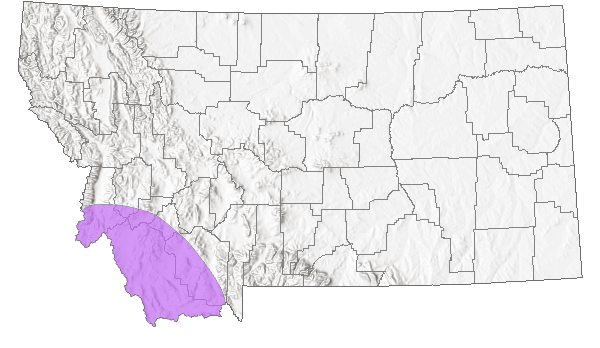
 Native
Native
Range Comments
WA to MT south to CA, NV and UT (Lesica et al. 2012. Manual of Montana Vascular Plants. BRIT Press. Fort Worth, TX).
Observations in Montana Natural Heritage Program Database
Number of Observations: 38
(Click on the following maps and charts to see full sized version)
Map Help and Descriptions
Relative Density
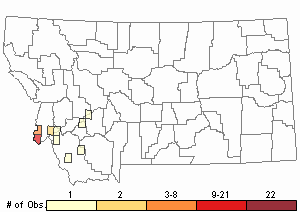
Recency
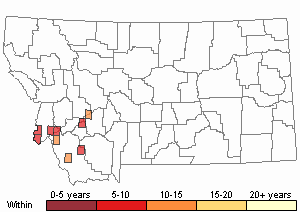
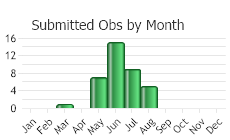
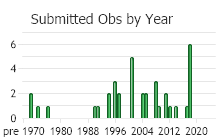
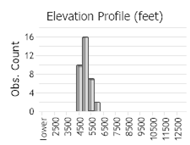 (Observations spanning multiple months or years are excluded from time charts)
(Observations spanning multiple months or years are excluded from time charts)
Habitat
Dry meadows, woods and margins in the foothill and lower montane zones.
Ecological Systems Associated with this Species
Ecology
POLLINATORS The following animal species have been reported as pollinators of this plant species or its genus where their geographic ranges overlap:
Bombus vagans,
Bombus appositus,
Bombus auricomus,
Bombus bifarius,
Bombus borealis,
Bombus centralis,
Bombus fervidus,
Bombus flavifrons,
Bombus frigidus,
Bombus huntii,
Bombus melanopygus,
Bombus mixtus,
Bombus nevadensis,
Bombus rufocinctus,
Bombus sylvicola,
Bombus ternarius,
Bombus occidentalis,
Bombus pensylvanicus,
Bombus bimaculatus,
Bombus griseocollis,
Bombus impatiens,
Bombus insularis,
Bombus suckleyi,
Bombus bohemicus,
Bombus flavidus, and
Bombus kirbiellus (Plath 1934, Hobbs 1966, Macior 1974, Heinrich 1976, Bauer 1983, Thorp et al. 1983, Mayer et al. 2000, Rao and Stephen 2007, Wilson et al. 2010, Colla and Dumesh 2010, Colla et al. 2011, Koch and Strange 2012, Koch et al. 2012, Miller-Struttmann and Galen 2014, Williams et al. 2014).
Stewardship Responsibility
Threats or Limiting Factors
STATE THREAT SCORE REASON
Reported threats to Montana's populations of Woolly-head Clover include impacts due to noxious weeds, and potential impacts from firewood gathering and recreation activity (MTNHP Threat Assessment 2021). Spotted Knapweed (Centaurea stoebe) occurs with low density at some populations with slight negative impacts. Noxious weed populations have potential to expand with greater negative impacts following ground disturbances that expose bare soil, such as firewood gathering and recreation activity. Information about the scope, severity, and timing of impacts from firewood gathering and/or recreational activities is needed to assess their contribution to impacts.
References
- Literature Cited AboveLegend:
 View Online Publication
View Online Publication Bauer, P.J. 1983. Bumblebee pollination relationships on the Beartooth Plateau tundra of Southern Montana. American Journal of Botany. 70(1): 134-144.
Bauer, P.J. 1983. Bumblebee pollination relationships on the Beartooth Plateau tundra of Southern Montana. American Journal of Botany. 70(1): 134-144. Colla, S., L. Richardson, and P. Williams. 2011. Bumble bees of the eastern United States. Washington, DC: USDA Forest Service, Pollinator Partnership. 103 p.
Colla, S., L. Richardson, and P. Williams. 2011. Bumble bees of the eastern United States. Washington, DC: USDA Forest Service, Pollinator Partnership. 103 p. Colla, S.R. and S. Dumesh. 2010. The bumble bees of southern Ontario: notes on natural history and distribution. Journal of the Entomological Society of Ontario 141:39-68.
Colla, S.R. and S. Dumesh. 2010. The bumble bees of southern Ontario: notes on natural history and distribution. Journal of the Entomological Society of Ontario 141:39-68. Hobbs, G.A. 1966b. Ecology of species of Bombus Latr. (Hymenoptera: Apidae) in southern Alberta. V. Subgenus Subterraneobombus Vogt. Canadian Entomologist 98: 288-294.
Hobbs, G.A. 1966b. Ecology of species of Bombus Latr. (Hymenoptera: Apidae) in southern Alberta. V. Subgenus Subterraneobombus Vogt. Canadian Entomologist 98: 288-294. Koch, J., J. Strange, and P. Williams. 2012. Bumble bees of the western United States. Washington, DC: USDA Forest Service, Pollinator Partnership. 143 p.
Koch, J., J. Strange, and P. Williams. 2012. Bumble bees of the western United States. Washington, DC: USDA Forest Service, Pollinator Partnership. 143 p. Koch, J.B. and J.P. Strange. 2012. The status of Bombus occidentalis and B. moderatus in Alaska with special focus on Nosema bombi incidence. Northwest Science 86:212-220.
Koch, J.B. and J.P. Strange. 2012. The status of Bombus occidentalis and B. moderatus in Alaska with special focus on Nosema bombi incidence. Northwest Science 86:212-220. Lesica, P., M.T. Lavin, and P.F. Stickney. 2012. Manual of Montana Vascular Plants. Fort Worth, TX: BRIT Press. viii + 771 p.
Lesica, P., M.T. Lavin, and P.F. Stickney. 2012. Manual of Montana Vascular Plants. Fort Worth, TX: BRIT Press. viii + 771 p. Macior, L.M. 1974. Pollination ecology of the Front Range of the Colorado Rocky Mountains. Melanderia 15: 1-59.
Macior, L.M. 1974. Pollination ecology of the Front Range of the Colorado Rocky Mountains. Melanderia 15: 1-59. Mayer, D.F., E.R. Miliczky, B.F. Finnigan, and C.A. Johnson. 2000. The bee fauna (Hymenoptera: Apoidea) of southeastern Washington. Journal of the Entomological Society of British Columbia 97: 25-31.
Mayer, D.F., E.R. Miliczky, B.F. Finnigan, and C.A. Johnson. 2000. The bee fauna (Hymenoptera: Apoidea) of southeastern Washington. Journal of the Entomological Society of British Columbia 97: 25-31. Miller-Struttmann, N.E. and C. Galen. 2014. High-altitude multi-taskers: bumble bee food plant use broadens along an altitudinal productivity gradient. Oecologia 176:1033-1045.
Miller-Struttmann, N.E. and C. Galen. 2014. High-altitude multi-taskers: bumble bee food plant use broadens along an altitudinal productivity gradient. Oecologia 176:1033-1045. MTNHP Threat Assessment. 2021. State Threat Score Assignment and Assessment of Reported Threats from 2006 to 2021 for State-listed Vascular Plants. Botany Program, Montana Natural Heritage Program, Helena, Montana.
MTNHP Threat Assessment. 2021. State Threat Score Assignment and Assessment of Reported Threats from 2006 to 2021 for State-listed Vascular Plants. Botany Program, Montana Natural Heritage Program, Helena, Montana. Plath, O.E. 1934. Bumblebees and their ways. New York, NY: Macmillan Company. 201 p.
Plath, O.E. 1934. Bumblebees and their ways. New York, NY: Macmillan Company. 201 p. Rao, S. and W.P. Stephen. 2007. Bombus (Bombus) occidentalis (Hymenoptera: Apidae): In decline or recovery. Pan-Pacific Entomoligist 83(4): 360-362.
Rao, S. and W.P. Stephen. 2007. Bombus (Bombus) occidentalis (Hymenoptera: Apidae): In decline or recovery. Pan-Pacific Entomoligist 83(4): 360-362. Thorp, R.W., D.S. Horning, and L.L. Dunning. 1983. Bumble bees and cuckoo bumble bees of California (Hymenoptera: Apidae). Bulletin of the California Insect Survey 23:1-79.
Thorp, R.W., D.S. Horning, and L.L. Dunning. 1983. Bumble bees and cuckoo bumble bees of California (Hymenoptera: Apidae). Bulletin of the California Insect Survey 23:1-79. Williams, P., R. Thorp, L. Richardson, and S. Colla. 2014. Bumble Bees of North America. Princeton, NJ: Princeton University Press. 208 p.
Williams, P., R. Thorp, L. Richardson, and S. Colla. 2014. Bumble Bees of North America. Princeton, NJ: Princeton University Press. 208 p. Wilson, J.S., L.E. Wilson, L.D. Loftis, and T. Griswold. 2010. The montane bee fauna of north central Washington, USA, with floral associations. Western North American Naturalist 70(2): 198-207.
Wilson, J.S., L.E. Wilson, L.D. Loftis, and T. Griswold. 2010. The montane bee fauna of north central Washington, USA, with floral associations. Western North American Naturalist 70(2): 198-207.
- Additional ReferencesLegend:
 View Online Publication
View Online Publication
Do you know of a citation we're missing? Lesica, P., M.T. Lavin, and P.F. Stickney. 2022. Manual of Montana Vascular Plants, Second Edition. Fort Worth, TX: BRIT Press. viii + 779 p.
Lesica, P., M.T. Lavin, and P.F. Stickney. 2022. Manual of Montana Vascular Plants, Second Edition. Fort Worth, TX: BRIT Press. viii + 779 p. Whitehead, B.K. 2020. The response of parafluvial soils to beaver mimicry restoration in a montane stream. M.Sc. Thesis. Bozeman, MT: Montana State University. 114 p.
Whitehead, B.K. 2020. The response of parafluvial soils to beaver mimicry restoration in a montane stream. M.Sc. Thesis. Bozeman, MT: Montana State University. 114 p.
- Web Search Engines for Articles on "Woolly-head Clover"





